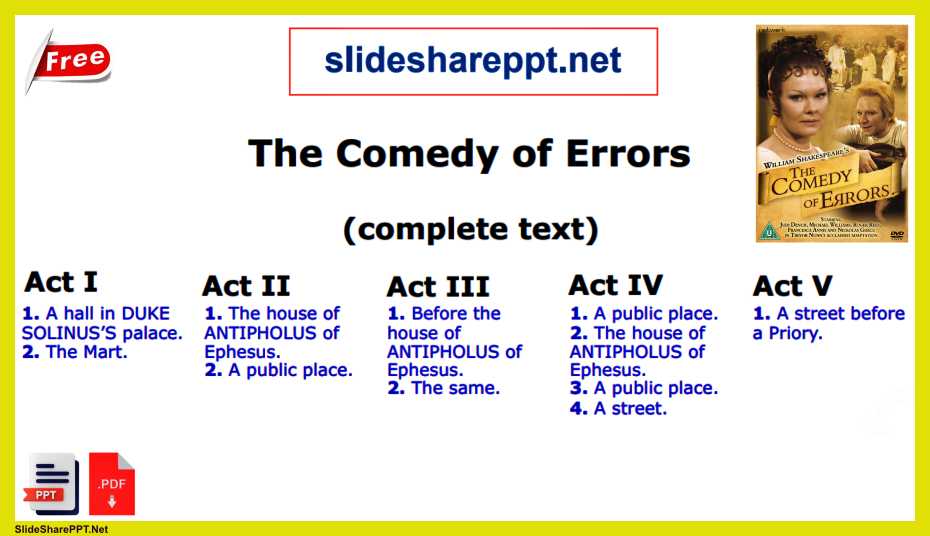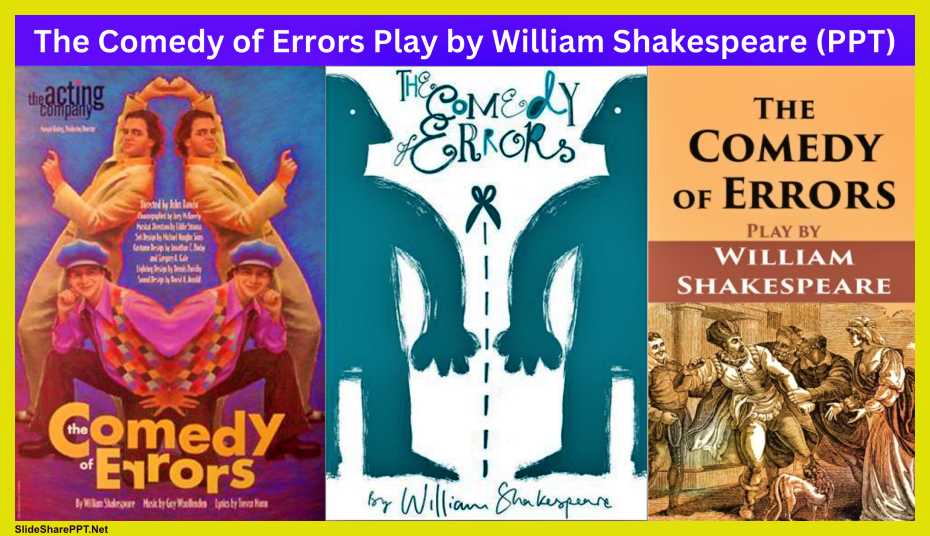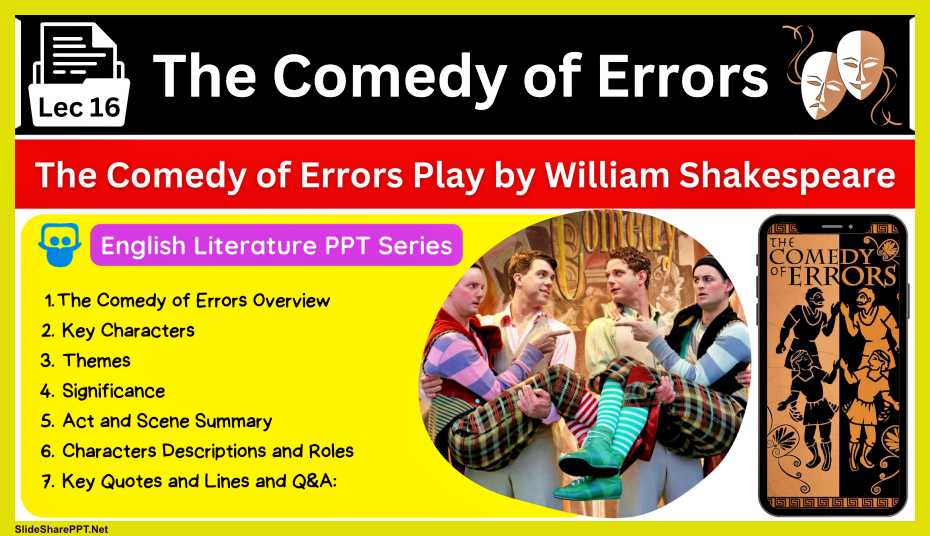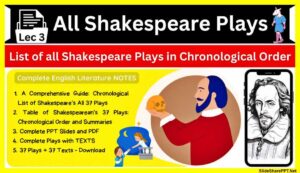The Comedy of Errors by William Shakespeare (Complete)
Contents
- 1 The Comedy of Errors by William Shakespeare (Complete)
- 1.1 The Comedy of Errors by William Shakespeare
- 1.2 (PPT Lec 16)
- 1.3 The Comedy of Errors by William Shakespeare
- 1.4 Exploring the Comedy of Errors by William Shakespeare
- 1.5 Summary and Act: The Comedy of Errors
- 1.6 Themes
- 1.7 Characters
- 1.8 Significance and Legacy
- 1.9 Key Quotes and Lines
- 1.10 QnA:
- 1.11 MCQ:
Today we have shared the Notes – The Comedy of Errors by William Shakespeare PPT Slides & PDF Download, So, as we know William Shakespeare, celebrated for his profound insights into the human condition, also reveals a playful and comedic side in “The Comedy of Errors.” Amidst the complexities of mistaken identities and farcical situations, Shakespeare weaves a tapestry of humor that transcends time and continues to enchant audiences across centuries. This comedic masterpiece, driven by witty wordplay, absurd coincidences, and the timeless theme of reunion, showcases Shakespeare’s genius in crafting a light-hearted yet deeply entertaining theatrical experience. Let’s delve into the layers of humor and enduring appeal that make “The Comedy of Errors” a beloved classic in the world of comedy literature.
The Comedy of Errors by William Shakespeare
(PPT Lec 16)
Important:-
- If you are viewing this PPT on your phone, please make it full screen and then view it. (Press: 3 dots in PPT, then Full Screen)
- If you have a problem while clicking on next, (Just tap) on the slide instead of clicking Next Botton.
- FOR A BETTER VIEW PRESS Ctrl + Shift + F ON A PC OR LAPTOP.
- Whatever is written in the PPT is different and whatever is written below is different.
The Comedy of Errors by William Shakespeare
Here’s a complete table for “The Comedy of Errors”:
| Aspect | Description |
|---|---|
| Title | The Comedy of Errors |
| Playwright | William Shakespeare |
| Genre | Comedy |
| Date of Composition | Estimated to be between 1589 and 1594 |
| Setting | Ephesus, a city in ancient Greece |
| Main Characters | Antipholus of Syracuse, Antipholus of Ephesus, Dromio of Syracuse, Dromio of Ephesus, Adriana, Luciana, Egeon |
| Plot Overview | The play revolves around the confusion and mistaken identity caused by two sets of identical twins separated at birth. Antipholus of Syracuse and his servant Dromio arrive in Ephesus, unaware that their long-lost twin brothers also reside there. Hilarity ensues as the characters navigate a series of misunderstandings and comedic mishaps. |
| Key Themes | Mistaken identity, confusion, deception, reconciliation, forgiveness |
| Significance | “The Comedy of Errors” is one of Shakespeare’s earliest and shortest comedies, known for its farcical humor and slapstick elements. While it may lack the depth of his later works, it remains popular for its entertaining plot and memorable characters. |
| Notable Lines | – “Am I in earth, in heaven, or in hell? / Sleeping or waking, mad or well-advised?” (Act 2, Scene 2) – “We came into the world like brother and brother; / And now let’s go hand in hand, not one before another.” (Act 5, Scene 1) – “I see two husbands, or mine eyes deceive me.” (Act 5, Scene 1) |
| Adaptations | Various stage productions, film adaptations, and television adaptations have been made over the years. Notable adaptations include the BBC Television Shakespeare series (1983) and the musical “The Boys from Syracuse” (1938). |
This table provides a comprehensive overview of various aspects of “The Comedy of Errors,” including its background, plot, characters, themes, significance, notable lines, and adaptations.
Exploring the Comedy of Errors by William Shakespeare
William Shakespeare, renowned as one of the greatest playwrights in history, crafted numerous timeless works that continue to captivate audiences centuries after they were written. Among his plays, “The Comedy of Errors” stands out as a delightful and farcical comedy that showcases Shakespeare’s mastery of language, wit, and comedic timing. Set against a backdrop of mistaken identities, slapstick humor, and familial reunions, this play remains a favorite among audiences and scholars alike for its enduring appeal and timeless themes.
Plot Overview
- “The Comedy of Errors” is one of Shakespeare’s earlier works and is believed to have been written in the mid-1590s. The play is based on Plautus’s “Menaechmi,” a Roman comedy known for its use of mistaken identity as a central plot device.
- The story revolves around two sets of identical twins, separated at birth during a shipwreck. Antipholus of Syracuse and his servant, Dromio of Syracuse, arrive in the city of Ephesus, unaware that their long-lost twin brothers, Antipholus of Ephesus and Dromio of Ephesus, reside there. The ensuing confusion and mistaken identities drive the plot forward, leading to a series of comedic misunderstandings.
- As the twins encounter various characters in Ephesus, including their respective wives, merchants, and friends, their identities become further entangled, resulting in uproarious situations. The play’s climax occurs when all characters converge in a chaotic scene of mistaken identities, only to be resolved in a classic Shakespearean comedic fashion.
Themes
- Identity and Appearance: The theme of mistaken identity serves as the foundation of the play, highlighting how outward appearances can lead to misunderstandings and comedic situations. Shakespeare explores the idea of identity beyond physical resemblance, delving into the complexities of character and personality.
- Familial Relationships: The play also delves into themes of family and reunion. The joyous moment when the twin brothers and their family members are reunited underscores the importance of familial bonds and forgiveness.
- Fate and Coincidence: “The Comedy of Errors” is filled with coincidences and twists of fate that drive the plot forward. Shakespeare weaves these elements seamlessly into the narrative, adding depth to the comedic chaos unfolding on stage.
Character Analysis
- Antipholus of Syracuse and Antipholus of Ephesus: The twin brothers, despite their identical appearance, possess distinct personalities shaped by their respective experiences. Antipholus of Syracuse is portrayed as more rational and bewildered by the events in Ephesus, while Antipholus of Ephesus is depicted as hot-tempered and confused by the sudden changes in his life.
- Dromio of Syracuse and Dromio of Ephesus: The loyal and quick-witted servants add layers of humor to the play with their witty banter and comedic timing. Their interactions with their masters and other characters provide comic relief amidst the confusion.
Significance and Legacy
- “The Comedy of Errors” may be categorized as a farce, yet beneath its surface of comedic antics lies Shakespeare’s keen insight into human nature and relationships. The play’s enduring popularity is a testament to its universal themes and timeless humor, ensuring its frequent inclusion in theater productions, adaptations, and scholarly discussions.
- Through mistaken identities, witty wordplay, and uproarious situations, Shakespeare invites audiences to ponder the complexities of identity, fate, and the bonds that unite us as family and society. The play’s ability to entertain and provoke thought has cemented its place as a beloved classic in the Shakespearean canon.
Conclusion
- In “The Comedy of Errors,” William Shakespeare masterfully weaves together elements of mistaken identity, comedic timing, and familial bonds to create a timeless comedy that continues to enchant audiences across generations. Through its rich characterizations, witty dialogue, and exploration of universal themes, the play remains a testament to Shakespeare’s enduring legacy as a playwright who effortlessly blends humor with profound insights into the human condition. As audiences continue to revel in its comedic chaos, “The Comedy of Errors” remains a shining example of Shakespearean brilliance and theatrical entertainment at its finest.

Note: The complete Text PDF Link is at the end of the PowerPoint slides (go to the last PPT Slide)
Summary and Act: The Comedy of Errors
“The Comedy of Errors” by William Shakespeare is a farcical comedy that revolves around two sets of identical twins separated at birth during a shipwreck. Antipholus of Syracuse and his servant, Dromio of Syracuse, arrive in Ephesus, unaware of their twin brothers, Antipholus of Ephesus and Dromio of Ephesus, who already live there. The play’s humor stems from mistaken identities as the characters confuse one twin for the other, leading to absurd and hilarious situations. Shakespeare employs witty wordplay, puns, and clever dialogue to enhance the comedic elements, creating a sense of chaotic confusion that drives the plot forward. As misunderstandings escalate, so do the complications, including accusations of infidelity and mistaken identities in darkened rooms. However, the play concludes with joyful reunions, resolutions of mistaken identities, and themes of forgiveness and reconciliation, highlighting deeper emotional undertones beneath the comedic surface. “The Comedy of Errors” remains a timeless classic due to its blend of physical comedy, verbal wit, and universal themes, ensuring its enduring appeal for audiences across generations.
Here is a table summarizing “The Comedy of Errors” by William Shakespeare based on its acts and scenes:
| Act | Scene | Summary |
|---|---|---|
| 1 | 1 | In the city of Syracuse, Egeon tells his story of being condemned to death for violating Ephesian law by entering the city. He mentions losing his wife, one of his twin sons, and a servant in a shipwreck. |
| 2 | Antipholus of Syracuse and his servant Dromio arrive in Ephesus, unaware that it is forbidden for them to be there. Antipholus sends Dromio to deposit money at an inn but discovers that he has returned with a gold chain instead. | |
| 2 | 1 | Antipholus of Ephesus scolds Dromio of Ephesus for not delivering the gold chain he was supposed to take to his wife, Adriana. Meanwhile, Antipholus of Syracuse is enchanted by Adriana’s sister, Luciana, who mistakes him for his twin. |
| 3 | 1 | Antipholus of Syracuse receives the gold chain intended for his twin and is subsequently arrested by officers who mistake him for Antipholus of Ephesus. Dromio of Syracuse manages to escape. |
| 2 | Antipholus of Ephesus arrives at his home to find the doors locked. His wife, Adriana, believing him to be inside with another woman, accuses him of infidelity. Meanwhile, Dromio of Syracuse confuses Antipholus of Ephesus with his twin. | |
| 4 | 1 | Antipholus of Syracuse is rescued from the officer by a merchant, who invites him to dinner. Meanwhile, Dromio of Ephesus reports to Adriana about Antipholus of Syracuse’s strange behavior. |
| 5 | 1 | The confusion escalates as Antipholus of Syracuse denies knowing Adriana or being married. Antipholus of Ephesus arrives with an officer, demanding his brother’s release, but is denied. |
| 2 | The Abbess, revealed to be Egeon’s lost wife, intervenes and brings everyone to her abbey. The identity confusion is finally unraveled as the twins and their family are reunited. Egeon’s life is spared, and all misunderstandings are resolved. |
This table outlines the key events and themes of each act and scene in “The Comedy of Errors,” capturing the essence of Shakespeare’s comedic masterpiece.
Themes
Here is a table outlining some of the key themes explored in William Shakespeare’s “The Comedy of Errors”:
| Theme | Description |
|---|---|
| Mistaken Identity | The central theme driving the plot, as characters mistake one twin and his servant for the other, leading to comedic misunderstandings and chaos. |
| Family and Reunion | The play explores the bonds of family and the joy of reunion as the twin brothers and their family members are finally reunited after years of separation. |
| Identity and Self | Characters grapple with questions of identity and self-awareness, especially as they navigate the confusion caused by mistaken identities. |
| Love and Relationships | Romantic entanglements and relationships are explored, including the love interests of the twin brothers and the complexities within marriage and fidelity. |
| Comedy and Humor | The play’s comedic elements, including wordplay, situational humor, and absurd situations, contribute to its light-hearted and entertaining tone. |
| Forgiveness | Themes of forgiveness and reconciliation are prominent as characters forgive past misunderstandings and come together in harmony by the play’s conclusion. |
These themes intertwine throughout the play, adding depth and complexity to the comedic storyline while also highlighting universal human experiences and emotions.
Characters
Here is a table outlining the main characters in William Shakespeare’s “The Comedy of Errors”:
| Character | Description |
|---|---|
| Antipholus of Syracuse | One of the twin brothers from Syracuse who, along with his servant Dromio of Syracuse, arrives in Ephesus and is mistaken for his twin counterpart. |
| Antipholus of Ephesus | The twin brother residing in Ephesus, confused by the strange behaviors of people who mistake his twin for him. |
| Dromio of Syracuse | The servant of Antipholus of Syracuse who shares a name with his Ephesian counterpart and adds to the mistaken identity confusion. |
| Dromio of Ephesus | The servant of Antipholus of Ephesus who is often bewildered by the bizarre situations arising from the mistaken identities. |
| Adriana | Antipholus of Ephesus’ wife who becomes suspicious of her husband’s actions, unaware of the twin’s confusion. |
| Luciana | Adriana’s sister who catches the eye of Antipholus of Syracuse and becomes entangled in the comedic misunderstandings. |
| Aegeon | A Syracusan merchant and father of the twin Antipholus brothers who faces execution in Ephesus, setting the stage for the play’s events. |
| Duke of Ephesus | The ruling authority in Ephesus who plays a crucial role in the resolution of Aegeon’s fate and the mistaken identities of the twins. |
| Courtesan | A woman is romantically involved with Antipholus of Ephesus, adding to the confusion and mistaken identities in the play. |
| Angelo | A goldsmith who mistakenly gives Antipholus of Syracuse a chain meant for Antipholus of Ephesus, leading to further misunderstandings. |
These are the main characters in the play, each contributing to the comedic chaos and misunderstandings that drive the plot forward in “The Comedy of Errors.”
Significance and Legacy
Here is a table highlighting the significance and legacy of William Shakespeare’s “The Comedy of Errors”:
| Aspect | Description |
|---|---|
| Early Work | “The Comedy of Errors” is one of Shakespeare’s early plays, believed to have been written around 1594. It showcases his early mastery of comedic elements. |
| Farcical Elements | The play is a classic example of farce, featuring mistaken identities, absurd situations, and comedic misunderstandings that drive the plot. |
| Influence on Comedy | Shakespeare’s use of mistaken identity and wordplay in this play has influenced countless comedies in literature, theater, and other forms of entertainment. |
| Exploration of Identity | The theme of mistaken identity allows for exploration of deeper themes such as identity, self-awareness, and the complexities of human relationships. |
| Universal Themes | Themes of family, reunion, love, forgiveness, and comedic humor resonate with audiences across time and cultures, contributing to the play’s enduring appeal. |
| Adaptations and Productions | “The Comedy of Errors” continues to be adapted into various mediums, including stage productions, films, and modern interpretations that highlight its timeless humor. |
These aspects highlight the lasting impact and significance of “The Comedy of Errors” in the realm of comedy, literature, and cultural entertainment, showcasing Shakespeare’s enduring legacy as a playwright and storyteller.
Key Quotes and Lines
Here are some key quotes and lines from William Shakespeare’s “The Comedy of Errors”:
| Quote | Speaker | Context |
|---|---|---|
| “A wretched soul, bruised with adversity.” | Aegeon | Aegeon speaks about his tragic life and the hardships he has faced, setting the tone for the play’s events. |
| “Am I in earth, in heaven, or in hell?” | Antipholus of Syracuse | Antipholus of Syracuse expresses his confusion upon arriving in Ephesus and encountering the mistaken identities. |
| “We came into the world like brother and brother.” | Dromio of Syracuse | Dromio reflects on the bond between the twin brothers, highlighting the theme of family and reunion in the play. |
| “There’s not a man I meet but doth salute me / As if I were their well-acquainted friend.” | Antipholus of Ephesus | Antipholus of Ephesus remarks on the strange behavior of people who mistake him for his twin brother. |
| “I to the world am like a drop of water / That in the ocean seeks another drop.” | Antipholus of Syracuse | Antipholus of Syracuse poetically describes his search for his lost family members, emphasizing the theme of reunion. |
| “I see two husbands, or mine eyes deceive me.” | Adriana | Adriana voices her suspicion upon seeing the twin Antipholuses together, unaware of the mistaken identities. |
| “I to the world am like a drop of water / That in the ocean seeks another drop.” | Antipholus of Syracuse | Antipholus of Syracuse poetically describes his search for his lost family members, emphasizing the theme of reunion. |
| “We cannot plead our love too long.” | Luciana | Luciana speaks about the persistence of love, highlighting the romantic themes in the play. |
| “We came into the world like brother and brother; / And now let’s go hand in hand, not one before another.” | Dromio of Ephesus | Dromio of Ephesus emphasizes the importance of unity and reconciliation, symbolizing the play’s resolution. |
These quotes capture the essence of key themes such as mistaken identity, family bonds, love, and reunion, while also showcasing Shakespeare’s masterful use of language and poetry in “The Comedy of Errors.”

QnA:
Q: When and where was “The Comedy of Errors” first performed?
A: “The Comedy of Errors” is believed to have been first performed in 1594. While the exact date of its premiere is not known, it is thought to have been staged at either The Theatre or The Rose Theatre in London, where many of Shakespeare’s early plays were performed.
Q: What is the main plot of “The Comedy of Errors”?
A: The main plot of “The Comedy of Errors” revolves around two sets of identical twins, separated at birth during a shipwreck. Antipholus of Syracuse and his servant, Dromio of Syracuse, arrive in the city of Ephesus, unaware that their twin brothers, Antipholus of Ephesus and his servant, Dromio of Ephesus, already reside there. The confusion begins when the Syracusans are mistaken for their Ephesian counterparts, leading to a series of comedic misunderstandings and absurd situations.
Q: What are some key themes explored in “The Comedy of Errors”?
A: Some key themes in “The Comedy of Errors” include:
- Mistaken Identity: The play revolves around the confusion caused by mistaken identities between the twin brothers and their servants.
- Family and Reunion: The joy of reuniting family members and the bonds of brotherhood are central themes.
- Love and Relationships: Romantic entanglements and marital misunderstandings add depth to the comedic plot.
- Identity and Self-Awareness: Characters grapple with questions of identity and recognition throughout the play.
- Comedy and Humor: The play is characterized by its farcical elements, wordplay, and situational humor.
Q: How does “The Comedy of Errors” reflect Shakespeare’s comedic style?
A: “The Comedy of Errors” reflects Shakespeare’s comedic style through its use of mistaken identity, wordplay, physical humor, and comedic misunderstandings. The play features witty dialogue, puns, and humorous situations that drive the plot forward while entertaining the audience.
Q: What is the significance of “The Comedy of Errors” in Shakespeare’s works?
A: “The Comedy of Errors” is significant in Shakespeare’s works as one of his early comedies, showcasing his developing skills in comedy and theatrical craftsmanship. It demonstrates his ability to weave intricate plots, use humor effectively, and explore universal themes within a comedic framework. The play also foreshadows elements and themes that Shakespeare would later explore in his more mature comedies.
MCQ:
Q: Who are the main characters in “The Comedy of Errors”?
A) Romeo and Juliet
B) Antipholus and Dromio
C) Hamlet and Ophelia
D) Macbeth and Lady Macbeth
Answer: B) Antipholus and Dromio
Q: What is the central theme of “The Comedy of Errors”?
A) Tragic fate
B) Mistaken identity
C) Revenge
D) Political intrigue
Answer: B) Mistaken identity
Q: Where does most of the confusion in the play arise from?
A) Characters’ love interests
B) Disputes over inheritance
C) Mistaken identities
D) Political conspiracies
Answer: C) Mistaken identities
Q: What city does the play primarily take place in?
A) London
B) Verona
C) Ephesus
D) Athens
Answer: C) Ephesus
Q: Which character is Aegeon looking for throughout the play?
A) His long-lost brother
B) His missing wife
C) His estranged son
D) His lost treasure
Answer: C) His estranged son
Read the Previous Post: A Midsummer Night’s Dream PPT Slides & PDF Download



